
United States gubernatorial elections were held on November 2, 1954, in 34 states, concurrent with the House and Senate elections. Elections also took place on September 13 in Maine. The special election in Florida was due to the death of incumbent governor Daniel T. McCarty on September 28, 1953.

United States gubernatorial elections were held in 1942, in 33 states, concurrent with the House and Senate elections, on November 3, 1942. Elections took place on September 14 in Maine.

United States gubernatorial elections were held in 1926, in 33 states, concurrent with the House and Senate elections, on November 2, 1926. Elections took place on October 5 in Arkansas, and September 13 in Maine.

United States gubernatorial elections were held in 1924, in 36 states, concurrent with the House, Senate elections and presidential election, on November 4, 1924. Elections took place on October 7 in Arkansas, and September 8 in Maine.

United States gubernatorial elections were held in 1922, in 33 states, concurrent with the House and Senate elections, on November 7, 1922. Elections took place on October 3 in Arkansas, and September 11 in Maine.

United States gubernatorial elections were held in 1918, in 32 states, concurrent with the House and Senate elections, on November 5, 1918. Elections took place on September 9 in Maine.

United States gubernatorial elections were held in 1916, in 36 states, concurrent with the House, Senate elections and presidential election, on November 7, 1916. Elections took place on September 11 in Maine.

United States gubernatorial elections were held in 1914, in 31 states, concurrent with the House and Senate elections, on November 3, 1914.

United States gubernatorial elections were held 31 states, concurrent with the House and Senate elections, on November 8, 1910.

United States gubernatorial elections were held in 1908, in 33 states, concurrent with the House, Senate elections and presidential election, on November 3, 1908.

United States gubernatorial elections were held in 1906, in 28 states, concurrent with the House and Senate elections, on November 6, 1906.

United States gubernatorial elections were held in 1902, in 27 states, concurrent with the House and Senate elections, on November 4, 1902.

United States gubernatorial elections were held in 1904, in 33 states, concurrent with the House, Senate elections and presidential election, on November 8, 1904.

United States gubernatorial elections were held in 1900, in 34 states, concurrent with the House, Senate elections and presidential election, on November 6, 1900.

United States gubernatorial elections were held in 1898, in 28 states, concurrent with the House and Senate elections, on November 8, 1898.

United States gubernatorial elections were held in 1896, in 32 states, concurrent with the House, Senate elections and presidential election, on November 3, 1896.

United States gubernatorial elections were held in 1894, in 28 states, concurrent with the House and Senate elections, on November 6, 1894.

United States gubernatorial elections were held in 1892, in 32 states, concurrent with the House, Senate elections and presidential election, on November 8, 1892.

United States gubernatorial elections were held in 1890, in 27 states, concurrent with the House and Senate elections, on November 4, 1890.
United States gubernatorial elections were held in 1888, in 26 states, concurrent with the House, Senate elections and presidential election, on November 6, 1888.



















